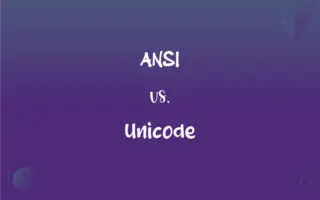Behind vs. Beside: What's the Difference?
Edited by Harlon Moss || By Janet White || Published on March 3, 2024
"Behind" means at the back of something, while "beside" means next to or at the side of something.

Key Differences
"Behind" refers to a position that is at the back part of something, indicating that an object or person is located at the rear of another object or person. "Beside," on the other hand, denotes a position directly next to or at the side of an object or person, implying closeness without being in front or at the back. This distinction is crucial in understanding spatial relationships in both physical and metaphorical contexts.
When you say something is "behind" you, it means that it is located in a direction that is opposite to the one you are facing. In contrast, when you mention something is "beside" you, it means it is on one side of you, without specifying whether it is to the left or right, just that it is adjacent. The use of "behind" and "beside" helps to convey precise spatial arrangements, which is fundamental in navigation, description, and spatial reasoning.
In literature and speech, "behind" can also have metaphorical meanings, such as being the underlying cause of something or being delayed. "Beside," however, can metaphorically mean being irrelevant or not comparable to something, as in "beside the point." These usages demonstrate the versatility of both prepositions beyond their primary spatial meanings, enriching language with depth and nuance.
The choice between "behind" and "beside" can affect the perception of a situation or narrative, highlighting the importance of precise language. For instance, being "behind" someone can imply support or following, while being "beside" someone can suggest companionship or equality. This subtle distinction can influence the interpretation of text or speech, emphasizing the power of prepositions in English.
Understanding the differences between "behind" and "beside" is essential for clear communication. Whether giving directions, describing a scene, or conveying metaphorical distances or relationships, these prepositions serve as key tools in the English language. They allow speakers and writers to articulate spatial concepts accurately, enhancing both clarity and expressiveness in communication.
ADVERTISEMENT
Comparison Chart
Spatial Relation
At the back of
Next to or at the side of
Direction
Opposite to the front
Alongside
Connotation
Following, supporting, or delayed
Adjacency, companionship, equality
Usage in Speech
Can indicate causality or tardiness
Can indicate irrelevance or comparison
Perception
Often implies a trailing or hidden position
Suggests closeness and accessibility
ADVERTISEMENT
Behind and Beside Definitions
Behind
Supporting or backing up.
The team stood behind their coach.
Beside
Adjacent to.
The library is located beside the museum.
Behind
Late or delayed in time.
I'm running behind schedule.
Beside
At the side of something or someone.
She sat beside me during the concert.
Behind
At the rear of something.
The garden is behind the house.
Beside
In comparison with.
Beside his expertise, my skills are modest.
Behind
Less advanced than.
Our technology is behind that of our competitors.
Beside
Supporting or accompanying.
Beside every great leader is a great advisor.
Behind
Hidden or underlying.
The truth behind the story was never revealed.
Beside
Apart from or except for.
Beside the main issue, there are several small problems.
Behind
In, to, or toward the rear
We walked behind.
Beside
At the side of; next to.
Behind
In a place or condition that has been passed or left
I left my gloves behind.
FAQs
What does "behind" indicate in spatial terms?
It indicates something at the back part of another thing.
Can "beside" mean the same as "next to"?
Yes, "beside" means next to or at the side of something.
Is "behind" only used for physical locations?
No, it can also have metaphorical meanings such as being delayed or the cause of something.
Can "beside" be used in non-physical contexts?
Yes, it can be used metaphorically to suggest comparison or irrelevance.
How do "behind" and "beside" differ in use?
"Behind" refers to a rear position, while "beside" refers to a side-by-side position.
How can "beside" be used to indicate support?
"He stood beside her during the trial."
What does "behind" imply in a competitive context?
It suggests being less advanced or trailing.
Is "beside" appropriate for giving directions?
Yes, especially when indicating that something is next to another.
Can "beside" imply equality?
Yes, being beside someone can suggest companionship or equality.
What is an example of "behind" used in a temporal sense?
"I'm running behind on my homework."
Can "behind" indicate causality?
Yes, as in "the reason behind the decision."
How does "behind" relate to performance?
It can describe being less advanced or needing to catch up.
How do "behind" and "beside" contribute to descriptive writing?
They help create clear spatial relationships and can add metaphorical depth.
Is "beside" used in academic writing?
Yes, especially in comparisons or discussions of adjacency.
What does "standing behind" someone imply in a teamwork context?
It implies offering support and solidarity.
Can "behind" suggest support or backing?
Yes, it can imply backing up or supporting someone or something.
How is "beside" used in a narrative to show relationship dynamics?
It can show closeness, support, or companionship between characters.
How does "behind" convey hidden meanings?
It can indicate underlying reasons or causes not immediately visible.
What is a metaphorical use of "beside"?
"His achievements are beside the point."
Can "beside" indicate a physical closeness only?
No, it can also indicate emotional or supportive closeness.
About Author
Written by
Janet WhiteJanet White has been an esteemed writer and blogger for Difference Wiki. Holding a Master's degree in Science and Medical Journalism from the prestigious Boston University, she has consistently demonstrated her expertise and passion for her field. When she's not immersed in her work, Janet relishes her time exercising, delving into a good book, and cherishing moments with friends and family.
Edited by
Harlon MossHarlon is a seasoned quality moderator and accomplished content writer for Difference Wiki. An alumnus of the prestigious University of California, he earned his degree in Computer Science. Leveraging his academic background, Harlon brings a meticulous and informed perspective to his work, ensuring content accuracy and excellence.







































































